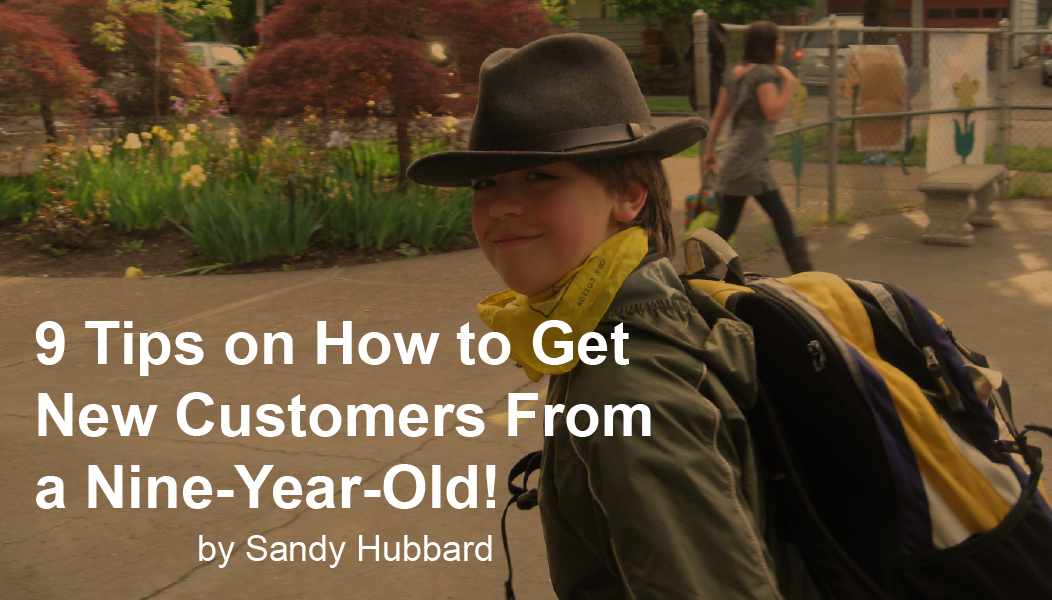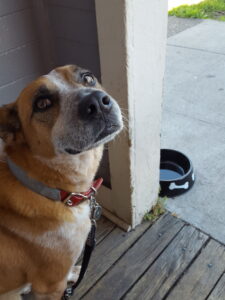Is it possible to get new customers in this topsy-turvy time? Here’s a story about a little kid who not only did it but created a winning nine-point formula.

My son, Nate, was nine years old when I was laid off from my corporate publishing job. The business had not bounced back from the Great Recession, and the printing industry was struggling to recover.
“I’m going to start a business,” he declared.
The next day he came home with his first customer.
“There’s a family that needs someone to take their dog out for a run every day,” he said. “I can exercise it after school. I’ll help buy groceries with the money.”

“You don’t have to do that…” I said, but he was out the door to take care of Client #1.
A few weeks later, he had Client #2.
“I met a family that doesn’t get home til after 7 o’clock, so their dog needs to be let out and have someone play with it.”
After that, he got Client #3, who was friends with Client #2. Client #4 was a bank teller who chatted with Nate each week when he made his business deposits. She was a busy dog owner as well.
He had four new customers! From networking! A little kid!
Meanwhile, I was deciding whether to find another corporate job. Looking at Nate’s system for getting new customers gave me hope for starting my own business during challenging economic times.
Here’s what I learned from Nate on how to get new customers — 9 tips from a nine-year-old:
- Knock on doors to find your best customers. As best you can in our contact-free environment, get face to face with folks. There are always people who want what you’re selling — and who are happy to pay for it. You have to put yourself out there consistently because people won’t pay attention — or remember you — until they need you.
- Figure out what you’re really selling. Nate wasn’t selling dog walking or dog exercising. He was addressing the guilt that people have in having to leave their dogs indoors all day.
- Know how to describe your ideal customer. Ask “Who needs a dog walker?” and people will say “I don’t know.” Instead, Nate asks: “Who’s the busiest family on the block?” If the entire family is gone all day, there’s no one at home to take the dog out. A family is more likely to have an active dog. He asks for THE busiest family, not a bunch of busy families. He makes it easy for people to imagine who would be a good fit.
- Don’t muddy the “ask.” Nate doesn’t ask for busy families with dogs. He can find out if they have a dog. That’s called qualifying the prospect. He just wants to know who fits the #1 profile — being busy.
- Go where the best prospects hang out. On weeknights and weekends, he goes to the dog park with his best customers and energetically plays with all the dogs off-leash. He knows his best prospects are there, trying to fit in quality time with their dogs.
- Don’t confuse introductions for prospects. Nate researches every introduction before pursuing it. Does the family treat the dog well? Do they understand that active dogs have special needs? Do they live nearby? Do they have the means to pay promptly? Nate never chased people who were a poor fit.
- Educate yourself. Because Nate was a dog exerciser — not a dog walker — he spent a lot of time learning about dog health for the breeds he worked with. He trained the dogs on habits and behavior so customers would notice the improvements. He learned how to give medication and treat common physical issues. His depth of knowledge was an asset, and it showed in his conversations with prospects.
- Give prospects a taste of what it’s like to do business with you. Even though Nate has an impeccable memory, he made a point to take down a prospect’s contact information to display his attention to detail. He promised to follow up and then kept that promise. He always took responsibility for the next steps in communicating because he knew his best prospects were busy and distracted. Before they hired him, people knew what it was like to work with Nate.
- Pay attention to your image. You didn’t have to wonder if Nate was doing well in business. He wore name-brand all-weather gear. He purchased quirky hats, sunglasses, and shoes. He exercised the dogs in interesting ways and at interesting venues. He liked challenging dogs. He worked on holidays. He volunteered. He introduced himself as a business owner. Visible success attracts attention.
After almost a decade of running his dog-exercising business, Nate headed off to college. He put the business on hold and thanked his customers with a half-page, full-color ad in our local newspaper. He kissed the dogs goodbye and parted with his clients on the best of terms.
In all those years, Nate never went without clients. He felt empowered to find new work whenever he wanted it. He had a formula for sales success that worked in any economic climate.
I hope these 9 tips from my son help you find new customers in this challenging time. If a nine-year-old kid can do it, so can you!
 Sandy Hubbard is an expert Marketing Strategist specializing in the Printing Industry. She consults with Print CEOs and owners of print, media, and platform businesses of all sizes — helping marketing teams build visibility and increase sales.
Sandy Hubbard is an expert Marketing Strategist specializing in the Printing Industry. She consults with Print CEOs and owners of print, media, and platform businesses of all sizes — helping marketing teams build visibility and increase sales.
Sandy is also co-host of #PrintChat, a weekly discussion on LinkedIn. Join the group here — and enjoy the fun at social media’s most popular chat for the global printing industry!











